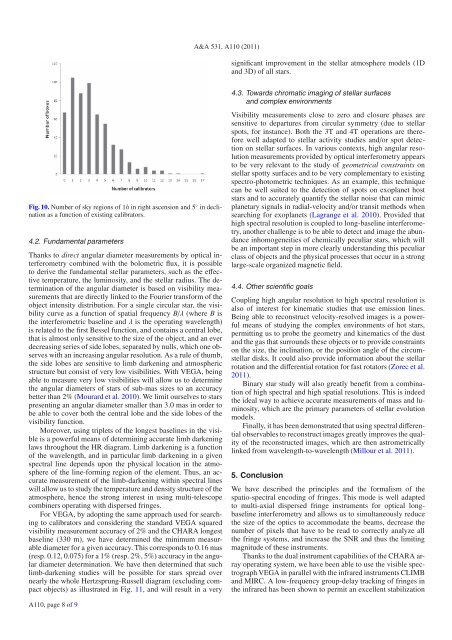Spatio-spectral encoding of fringes in optical long ... - GSU Astronomy
Spatio-spectral encoding of fringes in optical long ... - GSU Astronomy
Spatio-spectral encoding of fringes in optical long ... - GSU Astronomy
Create successful ePaper yourself
Turn your PDF publications into a flip-book with our unique Google optimized e-Paper software.
A&A 531, A110 (2011)significant improvement <strong>in</strong> the stellar atmosphere models (1Dand 3D) <strong>of</strong> all stars.Fig. 10. Number <strong>of</strong> sky regions <strong>of</strong> 1h <strong>in</strong> right ascension and 5 ◦ <strong>in</strong> decl<strong>in</strong>ationas a function <strong>of</strong> exist<strong>in</strong>g calibrators.4.2. Fundamental parametersThanks to direct angular diameter measurements by <strong>optical</strong> <strong>in</strong>terferometrycomb<strong>in</strong>ed with the bolometric flux, it is possibleto derive the fundamental stellar parameters, such as the effectivetemperature, the lum<strong>in</strong>osity, and the stellar radius. The determ<strong>in</strong>ation<strong>of</strong> the angular diameter is based on visibility measurementsthat are directly l<strong>in</strong>ked to the Fourier transform <strong>of</strong> theobject <strong>in</strong>tensity distribution. For a s<strong>in</strong>gle circular star, the visibilitycurve as a function <strong>of</strong> spatial frequency B/λ (where B isthe <strong>in</strong>terferometric basel<strong>in</strong>e and λ is the operat<strong>in</strong>g wavelength)is related to the first Bessel function, and conta<strong>in</strong>s a central lobe,that is almost only sensitive to the size <strong>of</strong> the object, and an everdecreas<strong>in</strong>g series <strong>of</strong> side lobes, separated by nulls, which one observeswith an <strong>in</strong>creas<strong>in</strong>g angular resolution. As a rule <strong>of</strong> thumb,the side lobes are sensitive to limb darken<strong>in</strong>g and atmosphericstructure but consist <strong>of</strong> very low visibilities. With VEGA, be<strong>in</strong>gable to measure very low visibilities will allow us to determ<strong>in</strong>ethe angular diameters <strong>of</strong> stars <strong>of</strong> sub-mas sizes to an accuracybetter than 2% (Mourard et al. 2010). We limit ourselves to starspresent<strong>in</strong>g an angular diameter smaller than 3.0 mas <strong>in</strong> order tobe able to cover both the central lobe and the side lobes <strong>of</strong> thevisibility function.Moreover, us<strong>in</strong>g triplets <strong>of</strong> the <strong>long</strong>est basel<strong>in</strong>es <strong>in</strong> the visibleis a powerful means <strong>of</strong> determ<strong>in</strong><strong>in</strong>g accurate limb darken<strong>in</strong>glaws throughout the HR diagram. Limb darken<strong>in</strong>g is a function<strong>of</strong> the wavelength, and <strong>in</strong> particular limb darken<strong>in</strong>g <strong>in</strong> a given<strong>spectral</strong> l<strong>in</strong>e depends upon the physical location <strong>in</strong> the atmosphere<strong>of</strong> the l<strong>in</strong>e-form<strong>in</strong>g region <strong>of</strong> the element. Thus, an accuratemeasurement <strong>of</strong> the limb-darken<strong>in</strong>g with<strong>in</strong> <strong>spectral</strong> l<strong>in</strong>eswill allow us to study the temperature and density structure <strong>of</strong> theatmosphere, hence the strong <strong>in</strong>terest <strong>in</strong> us<strong>in</strong>g multi-telescopecomb<strong>in</strong>ers operat<strong>in</strong>g with dispersed <strong>fr<strong>in</strong>ges</strong>.For VEGA, by adopt<strong>in</strong>g the same approach used for search<strong>in</strong>gto calibrators and consider<strong>in</strong>g the standard VEGA squaredvisibility measurement accuracy <strong>of</strong> 2% and the CHARA <strong>long</strong>estbasel<strong>in</strong>e (330 m), we have determ<strong>in</strong>ed the m<strong>in</strong>imum measurablediameter for a given accuracy. This corresponds to 0.16 mas(resp. 0.12, 0.075) for a 1% (resp. 2%, 5%) accuracy <strong>in</strong> the angulardiameter determ<strong>in</strong>ation. We have then determ<strong>in</strong>ed that suchlimb-darken<strong>in</strong>g studies will be possible for stars spread overnearly the whole Hertzsprung-Russell diagram (exclud<strong>in</strong>g compactobjects) as illustrated <strong>in</strong> Fig. 11, and will result <strong>in</strong> a very4.3. Towards chromatic imag<strong>in</strong>g <strong>of</strong> stellar surfacesand complex environmentsVisibility measurements close to zero and closure phases aresensitive to departures from circular symmetry (due to stellarspots, for <strong>in</strong>stance). Both the 3T and 4T operations are thereforewell adapted to stellar activity studies and/or spot detectionon stellar surfaces. In various contexts, high angular resolutionmeasurements provided by <strong>optical</strong> <strong>in</strong>terferometry appearsto be very relevant to the study <strong>of</strong> geometrical constra<strong>in</strong>ts onstellar spotty surfaces and to be very complementary to exist<strong>in</strong>gspectro-photometric techniques. As an example, this techniquecan be well suited to the detection <strong>of</strong> spots on exoplanet hoststars and to accurately quantify the stellar noise that can mimicplanetary signals <strong>in</strong> radial-velocity and/or transit methods whensearch<strong>in</strong>g for exoplanets (Lagrange et al. 2010). Provided thathigh <strong>spectral</strong> resolution is coupled to <strong>long</strong>-basel<strong>in</strong>e <strong>in</strong>terferometry,another challenge is to be able to detect and image the abundance<strong>in</strong>homogeneities <strong>of</strong> chemically peculiar stars, which willbe an important step <strong>in</strong> more clearly understand<strong>in</strong>g this peculiarclass <strong>of</strong> objects and the physical processes that occur <strong>in</strong> a stronglarge-scale organized magnetic field.4.4. Other scientific goalsCoupl<strong>in</strong>g high angular resolution to high <strong>spectral</strong> resolution isalso <strong>of</strong> <strong>in</strong>terest for k<strong>in</strong>ematic studies that use emission l<strong>in</strong>es.Be<strong>in</strong>g able to reconstruct velocity-resolved images is a powerfulmeans <strong>of</strong> study<strong>in</strong>g the complex environments <strong>of</strong> hot stars,permitt<strong>in</strong>g us to probe the geometry and k<strong>in</strong>ematics <strong>of</strong> the dustand the gas that surrounds these objects or to provide constra<strong>in</strong>tson the size, the <strong>in</strong>cl<strong>in</strong>ation, or the position angle <strong>of</strong> the circumstellardisks. It could also provide <strong>in</strong>formation about the stellarrotation and the differential rotation for fast rotators (Zorec et al.2011).B<strong>in</strong>ary star study will also greatly benefit from a comb<strong>in</strong>ation<strong>of</strong> high <strong>spectral</strong> and high spatial resolutions. This is <strong>in</strong>deedthe ideal way to achieve accurate measurements <strong>of</strong> mass and lum<strong>in</strong>osity,which are the primary parameters <strong>of</strong> stellar evolutionmodels.F<strong>in</strong>ally, it has been demonstrated that us<strong>in</strong>g <strong>spectral</strong> differentialobservables to reconstruct images greatly improves the quality<strong>of</strong> the reconstructed images, which are then astrometricallyl<strong>in</strong>ked from wavelength-to-wavelength (Millour et al. 2011).5. ConclusionWe have described the pr<strong>in</strong>ciples and the formalism <strong>of</strong> thespatio-<strong>spectral</strong> <strong>encod<strong>in</strong>g</strong> <strong>of</strong> <strong>fr<strong>in</strong>ges</strong>. This mode is well adaptedto multi-axial dispersed fr<strong>in</strong>ge <strong>in</strong>struments for <strong>optical</strong> <strong>long</strong>basel<strong>in</strong>e<strong>in</strong>terferometry and allows us to simultaneously reducethe size <strong>of</strong> the optics to accommodate the beams, decrease thenumber <strong>of</strong> pixels that have to be read to correctly analyze allthe fr<strong>in</strong>ge systems, and <strong>in</strong>crease the SNR and thus the limit<strong>in</strong>gmagnitude <strong>of</strong> these <strong>in</strong>struments.Thanks to the dual <strong>in</strong>strument capabilities <strong>of</strong> the CHARA arrayoperat<strong>in</strong>g system, we have been able to use the visible spectrographVEGA <strong>in</strong> parallel with the <strong>in</strong>frared <strong>in</strong>struments CLIMBand MIRC. A low-frequency group-delay track<strong>in</strong>g <strong>of</strong> <strong>fr<strong>in</strong>ges</strong> <strong>in</strong>the <strong>in</strong>frared has been shown to permit an excellent stabilizationA110, page 8 <strong>of</strong> 9












